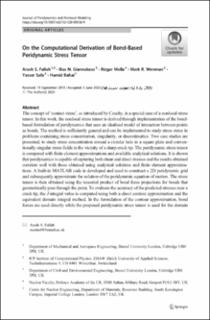Please use this identifier to cite or link to this item:
https://doi.org/10.21256/zhaw-20268Full metadata record
| DC Field | Value | Language |
|---|---|---|
| dc.contributor.author | Soleiman Fallah, Arash | - |
| dc.contributor.author | Giannakeas, Ilias N. | - |
| dc.contributor.author | Mella, Rizgar | - |
| dc.contributor.author | Wenman, Mark R. | - |
| dc.contributor.author | Safa, Yasser | - |
| dc.contributor.author | Bahai, Hamid | - |
| dc.date.accessioned | 2020-07-20T07:38:14Z | - |
| dc.date.available | 2020-07-20T07:38:14Z | - |
| dc.date.issued | 2020-07-02 | - |
| dc.identifier.issn | 2522-8978 | de_CH |
| dc.identifier.issn | 2522-896X | de_CH |
| dc.identifier.uri | https://digitalcollection.zhaw.ch/handle/11475/20268 | - |
| dc.description.abstract | The concept of ‘contact stress’, as introduced by Cauchy, is a special case of a nonlocal stress tensor. In this work, the nonlocal stress tensor is derived through implementation of the bond-based formulation of peridynamics that uses an idealised model of interaction between points as bonds. The method is sufficiently general and can be implemented to study stress states in problems containing stress concentration, singularity, or discontinuities. Two case studies are presented, to study stress concentration around a circular hole in a square plate and conventionally singular stress fields in the vicinity of a sharp crack tip. The peridynamic stress tensor is compared with finite element approximations and available analytical solutions. It is shown that peridynamics is capable of capturing both shear and direct stresses and the results obtained correlate well with those obtained using analytical solutions and finite element approximations. A built-in MATLAB code is developed and used to construct a 2D peridynamic grid and subsequently approximate the solution of the peridynamic equation of motion. The stress tensor is then obtained using the tensorial product of bond force projections for bonds that geometrically pass through the point. To evaluate the accuracy of the predicted stresses near a crack tip, the J-integral value is computed using both a direct contour approximation and the equivalent domain integral method. In the formulation of the contour approximation, bond forces are used directly while the proposed peridynamic stress tensor is used for the domain method. The J-integral values computed are compared with those obtained by the finite element package Abaqus 2018. The comparison provides an indication on the accurate prediction of the state of stress near the crack tip. | de_CH |
| dc.language.iso | en | de_CH |
| dc.publisher | Springer | de_CH |
| dc.relation.ispartof | Journal of Peridynamics and Nonlocal Modeling | de_CH |
| dc.rights | http://creativecommons.org/licenses/by/4.0/ | de_CH |
| dc.subject | Peridynamics | de_CH |
| dc.subject | Stress tensor | de_CH |
| dc.subject | J-integral | de_CH |
| dc.subject | Discontinuity | de_CH |
| dc.subject | Singularity | de_CH |
| dc.subject.ddc | 530: Physik | de_CH |
| dc.title | On the computational derivation of bond-based peridynamic stress tensor | de_CH |
| dc.type | Beitrag in wissenschaftlicher Zeitschrift | de_CH |
| dcterms.type | Text | de_CH |
| zhaw.departement | School of Engineering | de_CH |
| zhaw.organisationalunit | Institute of Computational Physics (ICP) | de_CH |
| dc.identifier.doi | 10.1007/s42102-020-00036-9 | de_CH |
| dc.identifier.doi | 10.21256/zhaw-20268 | - |
| zhaw.funding.eu | No | de_CH |
| zhaw.originated.zhaw | No | de_CH |
| zhaw.publication.status | publishedVersion | de_CH |
| zhaw.publication.review | Peer review (Publikation) | de_CH |
| zhaw.webfeed | Simulation and Optimization | de_CH |
| zhaw.author.additional | No | de_CH |
| zhaw.display.portrait | Yes | de_CH |
| Appears in collections: | Publikationen School of Engineering | |
Files in This Item:
| File | Description | Size | Format | |
|---|---|---|---|---|
| 2020_Fallah-etal_Computational-derivation-of-bond-based-peridynamic-stress-tensor.pdf | 2.51 MB | Adobe PDF |  View/Open |
Show simple item record
Soleiman Fallah, A., Giannakeas, I. N., Mella, R., Wenman, M. R., Safa, Y., & Bahai, H. (2020). On the computational derivation of bond-based peridynamic stress tensor. Journal of Peridynamics and Nonlocal Modeling. https://doi.org/10.1007/s42102-020-00036-9
Soleiman Fallah, A. et al. (2020) ‘On the computational derivation of bond-based peridynamic stress tensor’, Journal of Peridynamics and Nonlocal Modeling [Preprint]. Available at: https://doi.org/10.1007/s42102-020-00036-9.
A. Soleiman Fallah, I. N. Giannakeas, R. Mella, M. R. Wenman, Y. Safa, and H. Bahai, “On the computational derivation of bond-based peridynamic stress tensor,” Journal of Peridynamics and Nonlocal Modeling, Jul. 2020, doi: 10.1007/s42102-020-00036-9.
SOLEIMAN FALLAH, Arash, Ilias N. GIANNAKEAS, Rizgar MELLA, Mark R. WENMAN, Yasser SAFA und Hamid BAHAI, 2020. On the computational derivation of bond-based peridynamic stress tensor. Journal of Peridynamics and Nonlocal Modeling. 2 Juli 2020. DOI 10.1007/s42102-020-00036-9
Soleiman Fallah, Arash, Ilias N. Giannakeas, Rizgar Mella, Mark R. Wenman, Yasser Safa, and Hamid Bahai. 2020. “On the Computational Derivation of Bond-Based Peridynamic Stress Tensor.” Journal of Peridynamics and Nonlocal Modeling, July. https://doi.org/10.1007/s42102-020-00036-9.
Soleiman Fallah, Arash, et al. “On the Computational Derivation of Bond-Based Peridynamic Stress Tensor.” Journal of Peridynamics and Nonlocal Modeling, July 2020, https://doi.org/10.1007/s42102-020-00036-9.
Items in DSpace are protected by copyright, with all rights reserved, unless otherwise indicated.